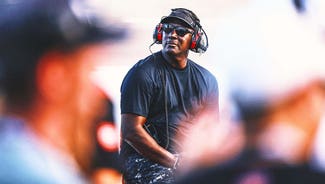
NASCAR prepares for new June race at Road America
Boris Said will always be a road-racing ace at heart.
So when the Milwaukee Mile racetrack was stricken with financial problems, the driver who hopes to run a full season in NASCAR this year couldn't imagine a better replacement on the Nationwide series schedule than Road America.
The zigzagging four-mile, 14-turn track has high-speed straightaways, challenging turns and plenty of places to pass - all cut through the rolling hills of a central Wisconsin forest, providing a setting that will look more like a state park than a racetrack when NASCAR arrives in June.
And oh, those gut-busting brats.
``It's got the best food of any racetrack in the world,'' said Said, who was at the track for a test session Wednesday.
The Milwaukee Mile oval currently does not have a promoter and has withdrawn from hosting major racing series indefinitely. But NASCAR didn't have to look far to find a new place for the June 19 race, shifting the Nationwide event about an hour north.
Nationwide series director Joe Balash said NASCAR was happy to find a way to stay in the Wisconsin market.
``It's unfortunate when you lose any venues on the circuit,'' Balash said. ``But to be able to come here, it's still close, we're still serving the same fans. And it's such a cool venue.''
NASCAR officials held a single-car test session at the track Wednesday to gather data for Nationwide series teams, with Said doing the driving.
Said has raced sports cars at Road America at least 20 times and considers it one of his favorite tracks in the world - right up there with legendary tracks such as Spa-Francorchamps in Belgium or the Nurburgring in Germany.
``I've raced all over the world, and this is probably the closest thing to a European Formula One track,'' he said.
Road America has been around 55 years, hosting everything from professional and amateur sports car races to motorcycle events and vintage car festivals. The stop for the now-defunct CART series drew big crowds for Indy-style racing in the 1980s and '90s.
NASCAR even was part of the track's formative years; Tim Flock won a Cup series race there in 1956.
The track does have some grandstands, but most fans prefer to spend the day wandering the track's expansive wooded grounds. The setting is so rustic that one of the biggest issues facing the track's management is finding a way to make sure deer don't wander on the track during a race (hint: this being Wisconsin, it involves hunting).
``It's the national park of speed,'' track president and general manager George Bruggenthies said.
Atmosphere aside, Said expects the Nationwide series to put on a good show.
The track has three long straightaways where Nationwide cars are expected to top out near 180 mph, all followed by sharp turns that will force drivers to downshift and jam on the brakes, providing several good passing opportunities.
``It's the only track that they haven't kind of put the 'restrictor plate' on - gotten rid of the fast corners, put chicanes in,'' Said said.
But racing through a forest can present a danger not found at other tracks, as Cristiano da Matta found out in 2006.
Da Matta was testing for his Champ Car series team when he hit a deer that had wandered onto the track, leaving da Matta with a serious head injury. After weeks in the hospital, he eventually made a full recovery.
Track officials do take steps to control the deer population, putting up fences and establishing wildlife-friendly habitat areas on the outskirts of the track's 640-acre property.
``We understand we have a responsibility to keep things safe for racers,'' Bruggenthies said.
And, yes, they hunt; Bruggenthies said track workers have year-round permits.
In the early morning hours before Said's test session began Wednesday, workers were expected to sweep the area with air horns - and rifles.
``Guys will be packin', absolutely,'' Bruggenthies said.
Said remembers his own frightening wildlife encounter at the Spa track in Belgium years ago, where he barely dodged a deer at 180 mph.
But as Said noted before Wednesday's test, NASCAR cars are significantly heavier than Indy-style cars and don't have an open cockpit - so in the unlikely event of a collision with what racers sometimes refer to as ``organic debris,'' he likes his chances.
``The deer's going to lose that one, for sure,'' Said said.
And given the crowds expected on the race weekend itself - Bruggenthies said fan response has been ``unbelievable'' so far - deer are less likely to come near the track when people are around.
``The only issue is, people will have stomachaches from eating so many brats,'' Said joked.

